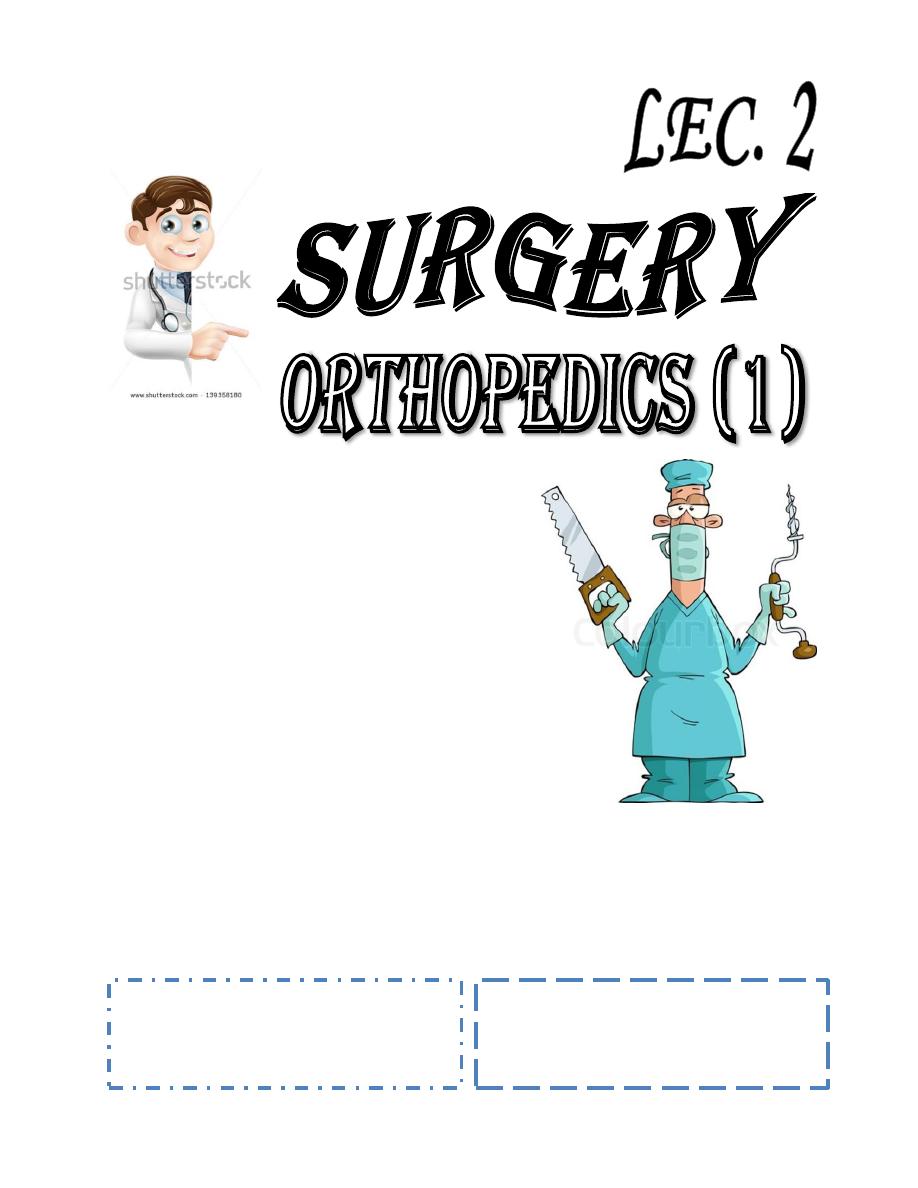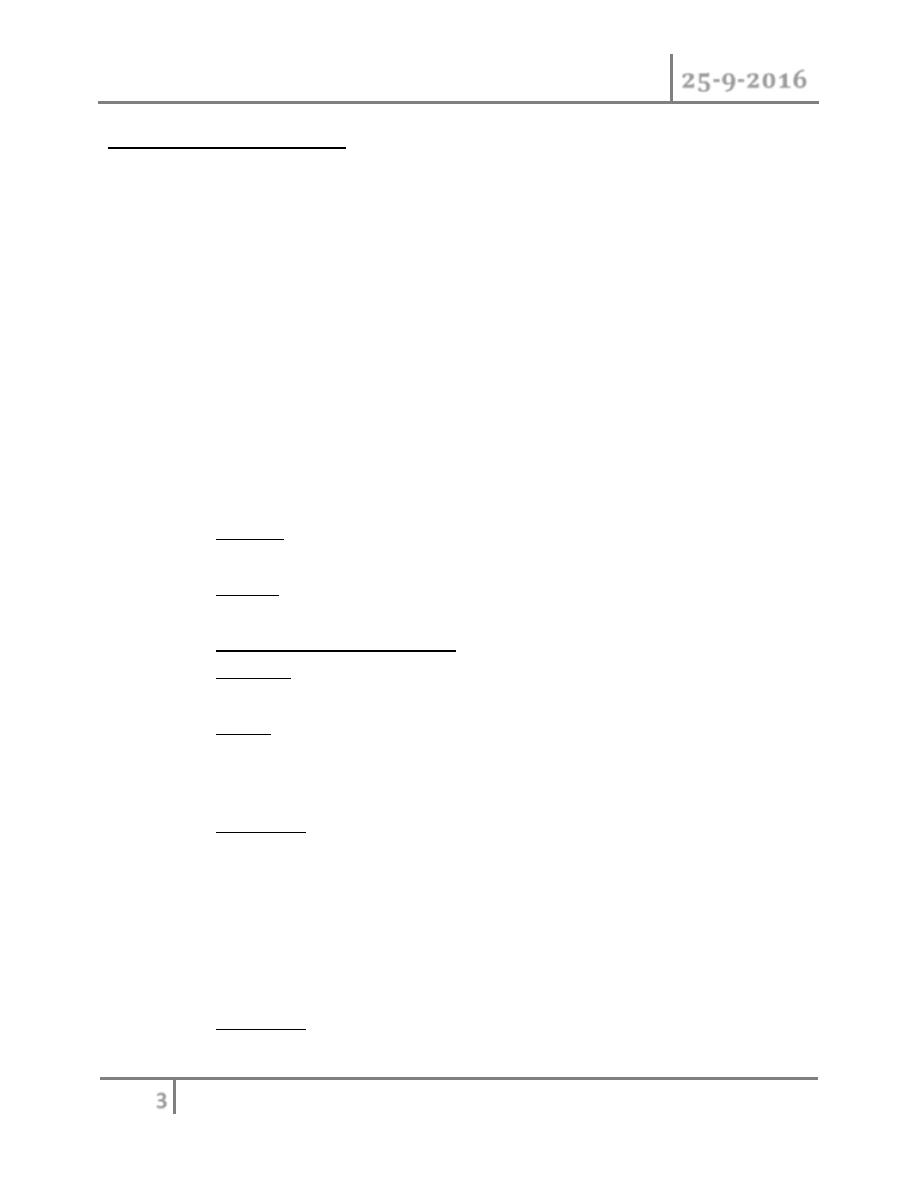
Baghdad College of Medicine / 5
th
grade
Student’s Name :
Dr. Mahmood Al-
Mashhadani
Lec. 1
Introduction in
Orthopedics
Sun. 25 / 9 / 2016
DONE BY : Ali Kareem
مكتب اشور لالستنساخ
2016 – 2017

Introduction in Orthopedics Dr. Mahmood
25-9-2016
2
©Ali Kareem 2016-2017
Introduction in Fracture & orthopedics
o Orthopedics concerns with bones, joints, muscles, tendon & nerves i.e.
skeletal system & all that make it move.
o Diagnosis begins with systematic gathering of information from history,
physical examination, X-ray & special investigations.
o Symptoms :
History can be very informative as examination or laboratory tests.
Orthopedic symptoms can be:
1. Pain.
2. Stiffness.
3. Swelling.
4. Deformity.
5. Change in sensation.
6. Loss of function.
Examination :
o In orthopedics examination is part of general patient exam or assessment.
We examine patient in 3 steps:
look, feel & move.
o Always assess the NEUROVASCULAR status of the part or limb.
X-ray examination :
o At least two views AP & lateral.
o Shows two joints one above & one below the area of examination.
o Show two limbs for comparison.
o Show the two bones in the forearm & leg.
o Taken at two different occasions to diagnose the disease and follow its
progression.

Introduction in Orthopedics Dr. Mahmood
25-9-2016
3
©Ali Kareem 2016-2017
Special imaging techniques :
o Contrast radiography : we use opaque liquids to outline sinuses,
arthrography to outline a joint or myelography to outline spinal canal.
o Tomography : give us a view focused in certain plain only.
o CT scan :
o Radioisotope scan :
o Ultrasound :
o MRI :
o Electrodiagnosis :
Orthopedic procedures
o Basic procedures:
Drilling : may be used to evacuate a bone abscess & most commonly
drill is used to prepare a hole in the bone for screw.
Cutting : cancellus bone can be cut by the osteotome while cortical
bone cut by an oscillating saw.
Modeling or reshaping bone : by a chisel or gouge.
Reaming meaning widening usually of medullary cavities of bone to
allow introduction of nail or prosthesis.
Fixing : bone fragments can be firmly joined or fixed by; screw, plate
and screw, long nails, wires, external fixator or others.
o Bony operations.
Osteotomy : it’s the procedure where we cut bone by osteotome or
saw to correct deformity or reshape the bone or to relieve pain of
arthritis. After osteotomy we can fix the bone by different fixation
methods or by POP.
The bone cuts are different e.g. transverse, oblique, wedge like -
osteotomies (open wedge or closed wedge sometimes-double wedge).
Bone graft : by taking bone from one site of body and putting it in a
new site it acts by two ways;

Introduction in Orthopedics Dr. Mahmood
25-9-2016
4
©Ali Kareem 2016-2017
They replace lost or missed bone. They stimulate new bone formation
o Leg equalization:
o Fixation of fracture.
o Operations on joints :
Arthroscopy : the interior of a joint can be visualized by inserting an
endoscope through a small incision. In addition introducing certain
instruments through separate portals can do certain operative
procedures.
Arthrotomy : it means surgical opening of a joint, its indications are:
a. To inspect the inside of the joint or taking synovial biopsy.
b. To drain heamatoma or abscess.
c. To remove loose bodies or damaged structures like torn meniscus.
d. To excise inflamed synovium (synovectomy).
Realignment osteotomy : used for the treatment of mild osteoarthritis
in young patients. We do osteotomy near the affected joint & realign
articular surfaces so that the less affected sides exposed to the
maximum weight bearing stresses. Usually the osteotomy is held by
internal fixation.
Arthrodesis : it means fusion of the joint in functional position used
for destroyed painful or unstable joint. There must be good
functioning proximal & distal joints & the principle of surgical
procedure is :
a. Removal of both joint surfaces & exposure of underlying bone.
b. The bones are apposed together in a functional position & fixing it
by internal fixation.
c. Bone graft is added to improve & hasten fusion.
d. The limb is splinted for 3-6 months until joint fusion & union.
Arthroplasty : these operations aim at pain relief & improvement of
range of movement. There are 3 different types:
a. Excesional arthroplasty: we excise good amount of bone & create
a gap instead of the joint which later get fibrosed & allow good
painless range of motion but the joint gets unstable e.g. hip

Introduction in Orthopedics Dr. Mahmood
25-9-2016
5
©Ali Kareem 2016-2017
excesional arthroplasty which is called Girdle-stone hip
arthroplasty.
b. Partial replacement arthroplasty: here only one joint surface is cut
& replaced by a prosthesis which is fixed to bone by fitting or bone
cement e.g. Austin-Moore hemiarthroplasty for fracture of femoral
neck.
c. Total joint replacement arthroplasty: as for the knee or hip. Here
both articular surfaces are cut and replaced by prosthesis that is
fitted to the bone or fixed to it by bone cement.
Amputations
o Dead (or dying), Dangerous & Damn nuisance.
o Site of amputation (where to do amputation):
o Prosthetic fitting of amputated limb:
o Complications of amputation : In addition to the complications of any
operation, amputation has specific complications as :
Early :
o Wound opening or dehiscence this due to ischemia or suturing under
tension.
o Gas gangrene especially in lower limb following vascular ischemia where
the clostridium spores from the perineum may infect the amputation.
Late :
1. Nerve :
o Painful neuroma; usually when we cut the nerve at the site of
amputation, it gets swollen & forms a bulb giving a tender and painful
neuroma that may need excision.
o Phantom phenomenon; it’s the feeling that the removed amputated
limb is still present. It needs good patient education before & after
surgery & good sedation it usually gradually disappear.
2. Artery : poor circulation gives blue cold stump liable to ulcerate & may
need re-amputation. This complication arises from wrong choice of
amputation site.

Introduction in Orthopedics Dr. Mahmood
25-9-2016
6
©Ali Kareem 2016-2017
o Common amputations are :
o
Toe amp., midfoot amp., Syme’s amp., below knee amp., through knee amp.,
above knee amp. & disarticulation through hip. Same in the upper l
#END of this Lecture …
